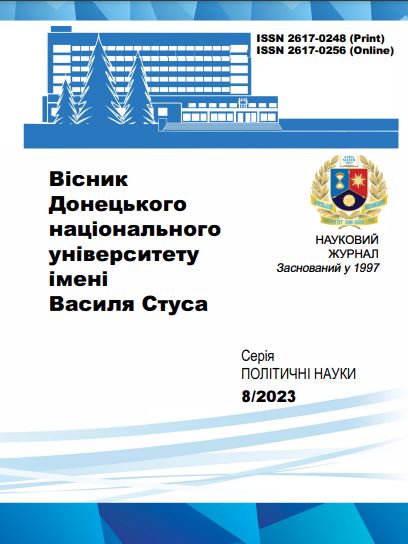The role of “national symbols” in political discourse
DOI:
https://doi.org/10.31558/2617-0248.2023.8.6Keywords:
national symbols; state symbols; political symbols; political discourseAbstract
The relevance of the study is due to the fact that, despite the certain popularity of “national symbols” in scientific and public discourses, “national symbols” as a category of political and social sciences is not clearly defined category, as well as their role in political discourse.
Therefore, the purpose of the research is to reveal the role of “national symbols” in political discourse. The research is based on systemic, interdisciplinary and discursive approaches, the use of which, to a large extent, has allowed us to achieve this goal. General scientific methods such as induction and deduction, analysis and synthesis, comparison and analogy, generalization and abstraction, as well as special scientific methods such as descriptive and content analysis, deconstruction and reconstruction, etc., were applied.
For some authors “national symbols” and “state symbols” are identical or almost identical concepts. They seem to be special, historically formed, distinctive distinguishing signs of the state established by national legislation (the Constitution of the state or its separate law), which embody its sovereignty and carry a certain ideology. Other authors, more reasonable, devide these concepts, understanding the category of “national symbols” much more broadly.
Political discourse, that leans on national context, and in particular on national symbols, that sets the metaphor of “nation” and is used in practical representation, will usually be reminiscent of the “nation”. And the existence of such a reminder is “normal”, ordinary situation in modern state politics.
However, “national symbols”, in particular the flag that hangs idly and does not sway in the wind, and the coat of arms engraved on coins, are not enough to preserve “our” usual understanding of the “nation”, the world and “our” place in it. They should unfold discursively. And for that, “banal words”, jingling in the ears of citizens or passing before their eyes, are required.
References
Денисюк С.Г. Символ як форма політичної комунікації. Держава і право. 2012. Вип. 55. С. 544–550.
Конституція України : станом на 1 верес. 2016 р. / Верховна Рада України. Харків : Право, 2016. 82 с.
Мамонтова Е.В. Державна символіка як індикатор політичного розвитку (на прикладі країн Центральної Азії та Казахстану). Актуальні проблеми політики. 2019. Вип. 63. С. 125–138.
Полянська В. Символічна політика: сутність, структура, умови реалізації. Політичний менеджмент. 2004. № 3. С. 87–97.
Прибєгін І.С. Національна ідентичність: концептуальні версії та їх реалізація в політичних процесах Ізраїлю: дис. … канд. політ. наук : 03.00.02 / Південноукр. нац. пед. ун-т імені К.Д. Ушинського. Одеса, 2021. 242 с.
Славіна О.В. Символізація політичної реальності : трансформація концептуального дискурсу: дис. … канд. політ. наук : 23.00.01 / Дніпропетровський нац. ун-т ім. Олеся Гончара. Дніпропетровськ, 2015. 237 с.
Слюсаревський М. Зміст і динаміка уявлень Українського суспільства про національні символи. Проблеми політичної психології. 2021. Вип. 10(24). С. 9–34.
Bantman C., Paola di P. Banal and everyday (inter)nationalism: French and Italian anarchist exiles in London, 1870s–1914. Nations and Nationalism. Vol.29. №1. 2022. P. 176–190.
Benwell M.C. Going Underground: Banal Nationalism and Subterranean Elements in Argentina’s Falklands/Malvinas Claim. Geopolitics. Vol.25. №1. 2017. P. 88–108.
Billig M. Banal nationalism. London : SAGE Publications. 2002. 200 p.
Cusack T. A ‘countryside bright with cosy homesteads’: Irish nationalism and the cottage landscape. National Identities. Vol.3. №3. 2001. P. 221–238.
Edensor T. National identity, popular culture and everyday life. Oxford: Berg. 2002. 224 p.
Hammett D. Envisaging the nation: The philatelic iconography of transforming South African national narratives. Geopolitics. Vol.17. №3. 2012. P. 526–552.
Ichijo A., Ranta R. Food, National Identity and Nationalism: From Everyday to Global Politics. Basingstoke, Palgrave Macmillan. 2016. 196 p.
Jones R., Merriman P. Hot, banal and everyday nationalism: Bilingual road signs in Wales. Political Geography. Vol.28. 2009. P. 164–173.
Lahoud A.L. The role of cultural (architecture) factors in forging identity. National Identities. Vol.10. №4. 2008. P. 389–398.
Paasi A. Dancing on the graves: independence, hot/banal nationalism and the mobilization of memory. Political Geography. Vol.54. 2016. P. 21–31.
Penrose J. Designing the nation. Banknotes, banal nationalism and alternative conceptions of the state. Political Geography. Vol.30. №8. 2011. P. 429–440.
Unwin T., Hewitt, V. Banknotes and national identity in central and eastern Europe. Political Geography. Vol.20. №8. 2001. P. 1005–1028.

